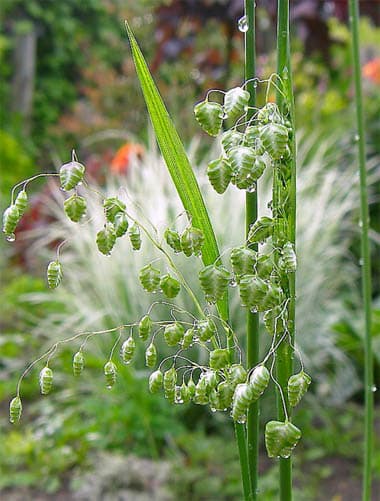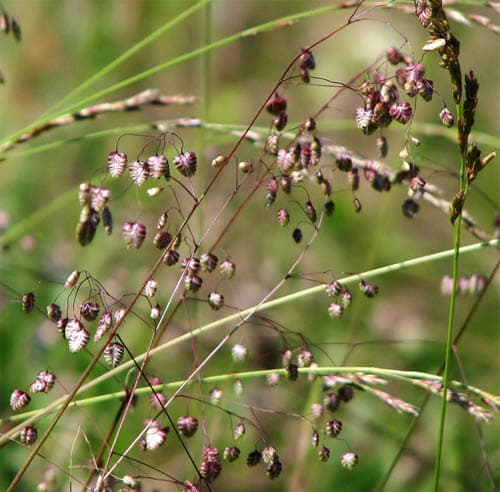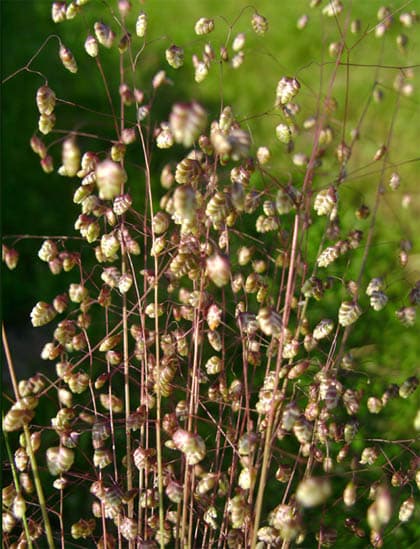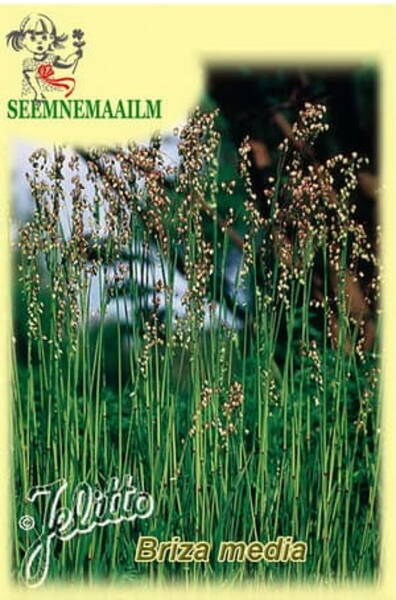Your shopping cart is empty!
Quaking-grass (Dodder-grass, Pearl Grass)
Dithering-grass (Cow-quake Tottergrass, Quaking-grass) - Briza media.
Forms surprisingly dynamic compositions in the foreground in mixed plantings, rocky hills and mixborders.
Thanks to rounded trembling spikelets, it looks great in dry bouquets, since dried inflorescences retain their shape and color for a long time.
Perennial plant from the Poaceae family.
Origin: Europe and Asia (poor soils of meadows, pastures and slopes).
Strong, upright habit with decorative heart-shaped spikelets. At different stages of the growing season, they can be colored green or red.
Natural flowering period: May - July.
Flowering plant height: 50 cm.
Distance between plants: 50 cm.
Foliage: narrow, lanceolate.
Winter hardiness zones: Z4 - Z7.
Usage: cut for bouquets, suitable for roof gardening.
1,0 g = 2400 seeds.

Germination: Rapidly germinating, keep seed in constant moisture (not wet) with temperatures of about +20°C. Do not cover the seed but tightly press into the earth. Keep in cooler conditions after germination occurs. The germination might be slower and more irregular. This poses no problems.
Scheduling.
Best Sowing Dates: Anytime Sowing to Germination: 2 - 3 weeks.
Germination to Transplant: 4 - 6 weeks.
Transplanting to Salable Plant: 6 - 8 weeks.
Cutting-Back at Transplanting: Not necessary.
Growing On: Container Size(s): 1 plug per 8/9 cm; 1-2 plugs per 11/12 cm; 2-3 plugs per 15 cm.
Vernalization: There is little advantage to vernalization even though a cold period won t do any harm on this or any perennial seed item.
Forcing: This species is not a suitable candidate for forcing.
Fertilization: Medium (150-200 ppm).
Forms surprisingly dynamic compositions in the foreground in mixed plantings, rocky hills and mixborders.
Thanks to rounded trembling spikelets, it looks great in dry bouquets, since dried inflorescences retain their shape and color for a long time.
Perennial plant from the Poaceae family.
Origin: Europe and Asia (poor soils of meadows, pastures and slopes).
Strong, upright habit with decorative heart-shaped spikelets. At different stages of the growing season, they can be colored green or red.
Natural flowering period: May - July.
Flowering plant height: 50 cm.
Distance between plants: 50 cm.
Foliage: narrow, lanceolate.
Winter hardiness zones: Z4 - Z7.
Usage: cut for bouquets, suitable for roof gardening.
1,0 g = 2400 seeds.

Germination: Rapidly germinating, keep seed in constant moisture (not wet) with temperatures of about +20°C. Do not cover the seed but tightly press into the earth. Keep in cooler conditions after germination occurs. The germination might be slower and more irregular. This poses no problems.
Scheduling.
Best Sowing Dates: Anytime Sowing to Germination: 2 - 3 weeks.
Germination to Transplant: 4 - 6 weeks.
Transplanting to Salable Plant: 6 - 8 weeks.
Cutting-Back at Transplanting: Not necessary.
Growing On: Container Size(s): 1 plug per 8/9 cm; 1-2 plugs per 11/12 cm; 2-3 plugs per 15 cm.
Vernalization: There is little advantage to vernalization even though a cold period won t do any harm on this or any perennial seed item.
Forcing: This species is not a suitable candidate for forcing.
Fertilization: Medium (150-200 ppm).


Quaking-grass, Cow-quake, Didder, Dithering-grass, Dodder-grass, Doddering Dillies, Doddle-grass, Earthquakes, Jiggle-joggles, Jockey-grass, Lady's-hair, Maidenhair-grass, Pearl Grass, Quakers-and-shakers, Shaking-grass, Tottergrass, Wag-wantons.












